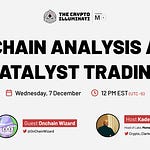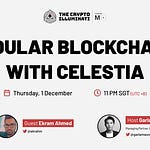Call Notes:
zkLend
Building a money market protocol on StarkNet - borrowing and lending products
zkLend currently offers two protocols
Artemis - a permissionless lending protocol focused on retail users and over-collateralized loans
Apollo - focused on KYC’d (Know Your Customer) borrowers like crypto hedge funds, VCs, and even other protocols being able to borrow under-collateralized
Jane: Co-founder of zkLend
She started her career in banking - did it for two years, but found it a bit too corporate for her liking
She wanted to do something more exciting and impactful so she could see her work making a difference
She joined a startup called Deliveroo - a food delivery company famous in Asia and Europe
Jane helped build out the team in Hong Kong back in 2016 - 2017
She loved this job - saw it as a mix of manual and strategic work
Enjoyed being able to strategize and execute.
A few years after this, Deliveroo IPO’d and she felt a plateau in her work trajectory, so she looked for new career opportunities
She was interested in crypto for some time, but she eventually delved deeper once her friends introduced her to different exchanges and parts of crypto
She was then introduced to Brian and Jonathan (the other two co-founders of zkLend) to start a project together
What was the first token you looked at?
She replied - Ethereum was the first one when her friend told her about it five years ago. Her friend was drawn to the smart contract capability and the future of that.
Types of Tokenomics Models and zkLend’s Model
Jane sees ‘tokenomics’ as a term that is too broad and may take a while to comprehend, so she breaks it down into a couple of buckets and functionalities:
Networks - specifically POS like Ethereum
The token's purpose is to allow users to stake the token to secure the network, receive fees, and payout rewards
The other part is for users to transact with protocols on that network
The participants are the users themselves - using dApps and paying the fees to transact, people staking to run their node - e.g., 32 $ETH needs to be staked to run a node, you can do this as an individual or through a pooling protocol like Rocket Pool or Lido
Jane sees networks as having the strongest tokenomics as the use case is clear for them
Opinion on some networks’ use of a ‘dual token model’ (one token for governance and one for incentives and utility)?
Jane sees this as a unique approach which she agrees with
People who hold the token may hold it for the sake of future potential but not as people interacting with it - do you want these people to have the power of governance?
Example; The Optimism Model -
Token’s house and Citizen’s house; the token’s house is for holders who want to vote on governance and upgrades
In comparison, Citizen’s house is for people to earn their way into being a voter, separating interests and aligning incentives
This is an early model open for evolution in the future
DeFi protocols - i.e., zkLend (eventually will have a token)
Like OlympusDAO - staking for emissions isn't working as it is too inflationary; people will dump tokens if there isn’t utility for them and would lose by hodling
You have to ensure holders are incentivized to use the protocol and put their tokens to use, which generates revenue for the protocol - this is the starting point of zkLend’s tokenomics
Of all tokenomics models - DeFi has the weakest in Jane’s opinion; due to poorly pronounced utility
In GameFi, you play the game to earn tokens and spend the tokens to buy in-game items, so utility here is straightforward, and revenue is generated
You have the option to convert the items or tokens into cash through a DEX
DeFi’s utility is quite vague - e.g., automated market makers generate revenue from people setting up liquidity pools
Still, you have other DeFi protocol models with tokens launching before the protocol (no initial utility = little incentive to hold), and people are staking for emissions
Jane and the team at zkLend wanted to focus on building a token in two ways
(1) emissions are centered around incentivizing activity on the protocol (borrowing and lending) to drive people to use it to earn
(2) a staking program in which users take on some risk as they are the safety module
Meaning that if anything happens to the pools once the reserves are depleted, the stakers will have to take on some risk, but in return, they can enjoy the benefits in terms of spread on the protocol
Where does the revenue for incentives come from?
Jane said that as a user, to borrow, you must deposit some assets into the protocol (BTC, ETH, USDC, etc.);
When you do this, you’re acting as a lender also, as this deposit can be lent to another user
Then, you choose which asset to borrow, and in return, you pay an interest rate on it; the utilization of the pool determines this
If a lot of people are borrowing ETH, the rate will be higher and vice versa for if fewer people are borrowing ETH
zkLend monetizes this process by taking the spread between the borrower and lender
More volatility = higher reserves to cover any more significant price swings
Governance token?
zkLend may have a governance token in the future, but for now, only $ZEND exists as they don't want to overcomplicate it by having two separate tokens at this stage and they want to see the dual token model prove itself more
$ZEND encompasses both Artemis and Apollo currently
$ZEND holders will be able to vote for governance proposals; it will be limited, so only users of Artimus can vote on Artimus proposals, and the same for Apollo; this is to align interests with incentives
‘Voter Apathy’ is quite significant in crypto (holding tokens but don't care about the protocol), so they want to avoid this
Which governance models work?
Jane said she likes “vote escrow’ which is a token lockup period before you can vote on a proposal, so they know users are in it for the long haul
Things like what happened with Mango Market on Solana show a no-lockup model doesn’t work.
Context: a hacker exploited Solend to drain funds from it and placed a ransom for the return of the money when the protocol held a proposal for voters to decide to pay up or not, and the hacker who stole the money was also allowed to be part of the voting.
Voting power based on holdings is unfair and will skew the votes; instead, Jane said she likes quadratic voting
This is a weighted system, the more votes you want, the more it will cost you per vote
There is still inequality, but it balances out governance by giving smaller holders more say
Which governance and tokenomics models do and don’t work?
Jane found how ETH proposals are voted on confusing as ETH users do not have any voting power, only the core developers - this deviates from many protocols as they do not consult the actual users. Furthermore, core contributors do not necessarily get rewarded directly by the network for building infrastructure (rather, stakers do)
StarkNet Tokenomics is slightly different from them as they saw the flaws in this design, as the results were paid out to the stakers exclusively. So StarkNet rewarded core contributors - software developers creating public infrastructure for the network.
StarkNet Tokenomics structure:
17% to Starkware investors (VCs)
32.9% to developers and partners
50.1% to the community
9% goes to community rebates (covers user onboarding fees)
12% to research grants
10% for ecosystem activities
2% for donations
8.1% unallocated to support the community
Jane finds this model quite attractive as it deviates from traditional designs focused on things like airdrops, and this makes sure the token has long-term potential
zkLend - $ZEND token distribution?
Jane stated that some tokens would be allocated to the startup investors - they raised $5 million in March
Allocation for team and advisors - they have a six-month cliff with quarterly vesting for three years
The vesting schedule is longer than usual to ensure the team is in it for the long term
Allocation for the ecosystem - used for incentives to users of the protocol
This is also for bootstrapping liquidity - airdrops, mining, or lock drop
Staking rewards allocation
$ZEND is deflationary - fixed supply, no way to increase it.
How is zkLend building its community? Strategy? Tips and tricks?
zkLend has a strong community, Jane stated that zkLend’s approach to introducing the protocol and StarkNet to the community is slightly different from others - StarkNet is still very early and not in total production yet, and zkLend is still on testnet
Hence, much of the focus is on educating the community and giving them the tools to understand what StarkNet is, what ZK rollups are, and why they are so good
This is in hopes of making their community feel more informed as crypto users and comfortable asking questions
They run fun interactive events in the Discord to allow members to feel more at home and relaxed within the community
Anything else for the community? AMAs?
ZEND&Friends series - talks with other DeFi protocols, lending protocols on other networks, StarkNet infrastructure plays, and StarkNet educators
This aimed to widen the knowledge available to their community and allow them to learn from experts
In-person events - promote StarkNet more thoroughly to spread the word
Turning points in community engagement?
The fundraising announcement was big
Discord - using roles in their Discord, they gave ‘trophies’ to their early adopters. When they announced them, people ran to join to get the roles
Raffles and exclusive events for early adopters
Final comments
Jane said they had deployed their testnet for Artemis on StarkNet - will soon go on mainnet (end of Q4/Early Q1)
Any suggestions or comments, you can send zkLend a DM on Twitter or Discord
Subscribe to receive our weekly newsletter and in-house research content!
Please Share, Leave Feedback, and Follow Us on Twitter, Telegram, and LinkedIn to stay connected with us.















Designing Community Incentives